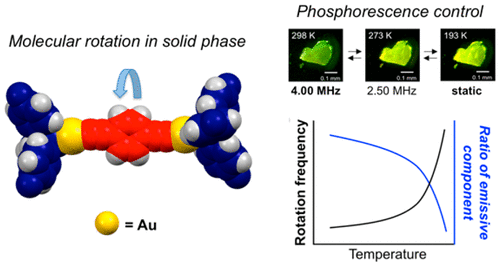Phosphorescence Control Mediated by Molecular Rotation and Aurophilic Interactions in Amphidynamic Crystals of 1,4-bis[tri-(p-fluorophenyl)phosphane-gold(I)-ethynyl]benzene

Here we present a structural design aimed at the control of phosphorescence emission as the result of changes in molecular rotation in a crystalline material. The proposed strategy includes the use of aurophilic interactions, both as a crystal engineering tool and as a sensitive emission probe, and the use of a dumbbell-shaped architecture intended to create a low packing density region that permits the rotation of a central phenylene. Molecular rotor 1, with a central 1,4-diethynylphenylene rotator linked to two gold(I) triphenylphosphane complexes, was prepared and its structure confirmed by single-crystal X-ray diffraction, which revealed chains mediated by dimeric aurophilic interactions. We showed that green-emitting crystals exhibit reversible luminescent color changes between 298 and 193 K, which correlate with changes in rotational motion determined by variable-temperature solid-state 2H NMR spin–echo experiments. Fast two-fold rotation with a frequency of ca. 4.00 MHz (τ = 0.25 μs) at 298 K becomes essentially static below 193 K as emission steadily changes from green to yellow in this temperature interval. A correlation between phosphorescence lifetimes and rotational frequencies is interpreted in terms of conformational changes arising from rotation of the central phenylene, which causes a change in electronic communication between the gold-linked rotors, as suggested by DFT studies. These results and control experiments with analogue 2, possessing a hindered tetramethylphenylene that is unable to rotate in the crystal, suggest that the molecular rotation can be a useful tool for controlling luminescence in the crystalline state.

